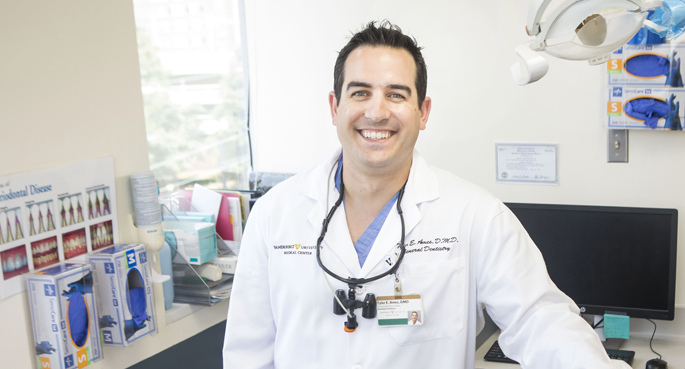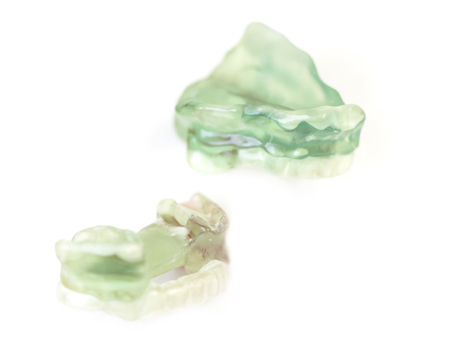
by Jill Clendening
When Laura McClure-Barnes, MD, learned she needed radiation therapy following surgery for adenoid cystic carcinoma, a rare cancer of the salivary glands, she knew that radiation could damage healthy tissue and bone near the tumor.
But because a doctor at Vanderbilt University Medical Center was willing to think outside the box to protect structures of her jaw and face from harm, she’s still smiling today, with only minor effects from her cancer treatment.
McClure-Barnes, a community oncologist, discovered the cancer tumor herself as she fretted over a sore spot in her mouth that she initially thought was an inflamed tooth. Ever since being treated for a childhood cancer — an osteogenic sarcoma that led to the amputation of her right leg in 1984 — she had dealt with a treatment after-effect of a chronically dry mouth. That, unfortunately, meant she developed cavities easily.
She reached into the back of her mouth one day and felt a mass. As a practicing oncologist who completed her fellowship training at VUMC, she knew she needed to get expert help quickly.
“I always knew I had some ongoing risk of a second malignancy, and as I became an oncologist, I became more concerned,” McClure-Barnes said. “But even when you have that in the back of your mind, you’re still shocked when it happens. This type of cancer was completely off my radar. I was thinking, ‘Look for breast cancer or colon cancer.’ This is not a common cancer.”
James Netterville, MD, Mark C. Smith Professor of Head and Neck Surgery, and director of Head and Neck Oncologic Surgery, successfully removed the tumor, but because cancer had spread to a lymph node and to the soft tissue of her face, chemotherapy and radiation therapy were next.
“I already had trouble with a dry mouth,” she said. “Then, they removed a salivary gland. There were other salivary glands that would be in the field of radiation that could be damaged, so I was very concerned.”
She credits a custom oral stent designed by Tyler Ames, DMD, an assistant professor in the VUMC Department of Oral and Maxillofacial Surgery, for protecting her face and jaw so the potential harm from radiation therapy was minimized. Created using thousands of digital pictures of the interior of her mouth and 3-D printing, the stent was crafted to fit her mouth perfectly during her radiation treatments.
“The radiation oncologist I went to for treatment was thrilled with the mouthpiece,” she said. “It opened my mouth further, and it was also designed to push my tongue away from where the tumor was removed. It moved part of my soft palate and part of my tongue completely out of the radiation field, which is awesome. After my treatments, there was a sharp line of demarcation on my tongue, so you could really see where it was pushed outside of the field. I know it really made a big difference.”
Ames, who met with McClure-Barnes immediately after her oral cancer diagnosis, practices at VUMC’s Dental Clinic at Villages at Vanderbilt and regularly performs cancer clearance exams. These are detailed dental evaluations that identify and resolve oral issues for cancer patients before surgery and treatment. He also cares for patients as they deal with the after effects of chemotherapy and radiation treatment.

Mucositis, one of the most common and debilitating complications of cancer treatment, occurs when the treatment damages the epithelial cells lining the gastro-intestinal tract, leading to ulcers, infection and increased mucus secretion. Oral mucositis causes pain, can significantly impact the ability to eat, and can negatively impact overall quality of life.
Osteoradionecrosis occurs when bone dies after radiation damages blood vessels that nourish the bone. When the jaw is affected, this can lead to tooth loss and infection. In the most severe cases, bone is harvested from another area of the body to reconstruct the jaw.
Other radiation-induced side effects often experienced by head and neck cancer patients include xerostomia, or lack of saliva flow; dysphagia, or difficulty swallowing; cavities; and trismus, or lockjaw.
“There’s a saying that the treatment for head and neck cancers is worse than the disease itself because of some of the consequences, especially from radiation,” Ames said. “The side effects from chemo are usually temporary. You might lose your hair, but it grows back. You might have nausea and vomiting, but that gets better. But radiation therapy to the head and neck, a very complex anatomic area, can leave some lasting phenomena. After seeing a lot of these cases, I was trying to figure out if there was anything at all I could do to help these patients and give them better protection.”
Ames met with Medical Center colleagues, medical physicist Gregory Twork, MSc, and radiation oncologist Kenneth Niermann, MD, MSCI, as well as David Jackson, the owner of MidSouth Dental Lab in Franklin, Tennessee. The four collaborated on planning and fabricating a stent model that could be used to move structures of the mouth out of the radiation field. To be successful, they knew such a stent would also have to be produced quickly and inexpensively and be easily customizable to individual patients.
A new intraoral scanner allowed Ames to take multiple digital images of the interior of McClure-Barnes’ mouth, documenting the exact shape and position of her teeth, as well as her unique bite, the spatial relationship of her top and bottom teeth.
A 3D printer — technology now increasingly used for dental applications such as creating crowns, dental prosthetics and models — was used in conjunction with special software to create the stent based on the images.
The final step was fitting the stent into McClure-Barnes’ mouth. During the fitting, the stent was shaped for comfort and light-curable denture material was added to achieve the best alignment. Then, McClure-Barnes took the stent to her radiology team where she put it in her mouth, so the radiotherapy mask used during her treatment could be molded accurately.
“This could be a time-consuming undertaking for a patient population that has a short timeline for treatment,” Ames said. “With these new technologies, we’ve been able to create these stents very quickly, within 24 hours. These patients need to get on with their cancer treatment.”
So far, about a dozen VUMC patients have been able to use the customized dental stents during their radiation therapy, Ames said. An ultimate test of the process occurred when one patient fractured his stent in the middle of radiation treatment. After a quick phone call from radiology to Ames, a replacement stent was ready to go the next day.
Today, you’d never know McClure-Barnes had undergone surgery and treatment for the cancer.
Her smile is wide and the incision from her surgery falls in a natural crease of her neck, making it nearly invisible.
Other than a bit of hoarseness in her voice, and the continued dry mouth, she has been able to get back to her life, her career and to spending time with her husband and their menagerie of animals at their farm in Gallatin, Tennessee.
“I’m in a really good place now,” said McClure-Barnes. “I’m back at work, and I can communicate with my patients. I’m very fortunate that this has not prevented me from continuing my career. This has all given me a new perspective, and I hope, in terms of how I interact with patients, it has helped me be more in tune with some of the issues they might be going through.”












